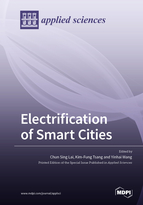Electrification of Smart Cities
A special issue of Applied Sciences (ISSN 2076-3417). This special issue belongs to the section "Energy Science and Technology".
Deadline for manuscript submissions: closed (31 January 2023) | Viewed by 38221
Special Issue Editors
Interests: smart energy management; smart grids; smart battery management systems; power system optimization; energy system modeling; data analytics; electric vehicle systems; hybrid powertrains optimization; energy economics for renewable energy and storage systems
Special Issues, Collections and Topics in MDPI journals
Interests: Internet of Things standards; sensors; wireless protocols; network optimization; emerging networks of Internet of Things; artificial intelligence for smart applications; blockchain and cyber security for Internet of Things
Special Issues, Collections and Topics in MDPI journals
Interests: infrastructure and smart cities; transportation engineering; traffic detection systems
Special Issues, Collections and Topics in MDPI journals
Special Issue Information
Electrification plays a key role in decarbonizing energy consumption for various sectors, including transportation, heating, and cooling. There are several essential infrastructures for a smart city, including smart grids and transportation networks. These infrastructures are the complementary solutions to successfully developing novel services, with enhanced energy efficiency and energy security.
This Special Issue seeks high-quality papers that address issues related to cutting-edge smart city technologies in the electrification process. Topics of interest for this Special Issue include, but are not limited to:
- Electrification of building environments and transportation systems;
- Role and impact of smart grids for smart cities;
- ICT and IoT infrastructures with big data for smart cities electrification;
- Market, services, and business models for smart cities electrification;
- Standards and implementation for smart cities electrification;
- Advanced smart grid technology integration in smart cities, such as energy storage, demand-side management, and distributed energy resources.
Dr. Chun Sing Lai
Dr. Kim-Fung Tsang
Prof. Yinhai Wang
Guest Editors








